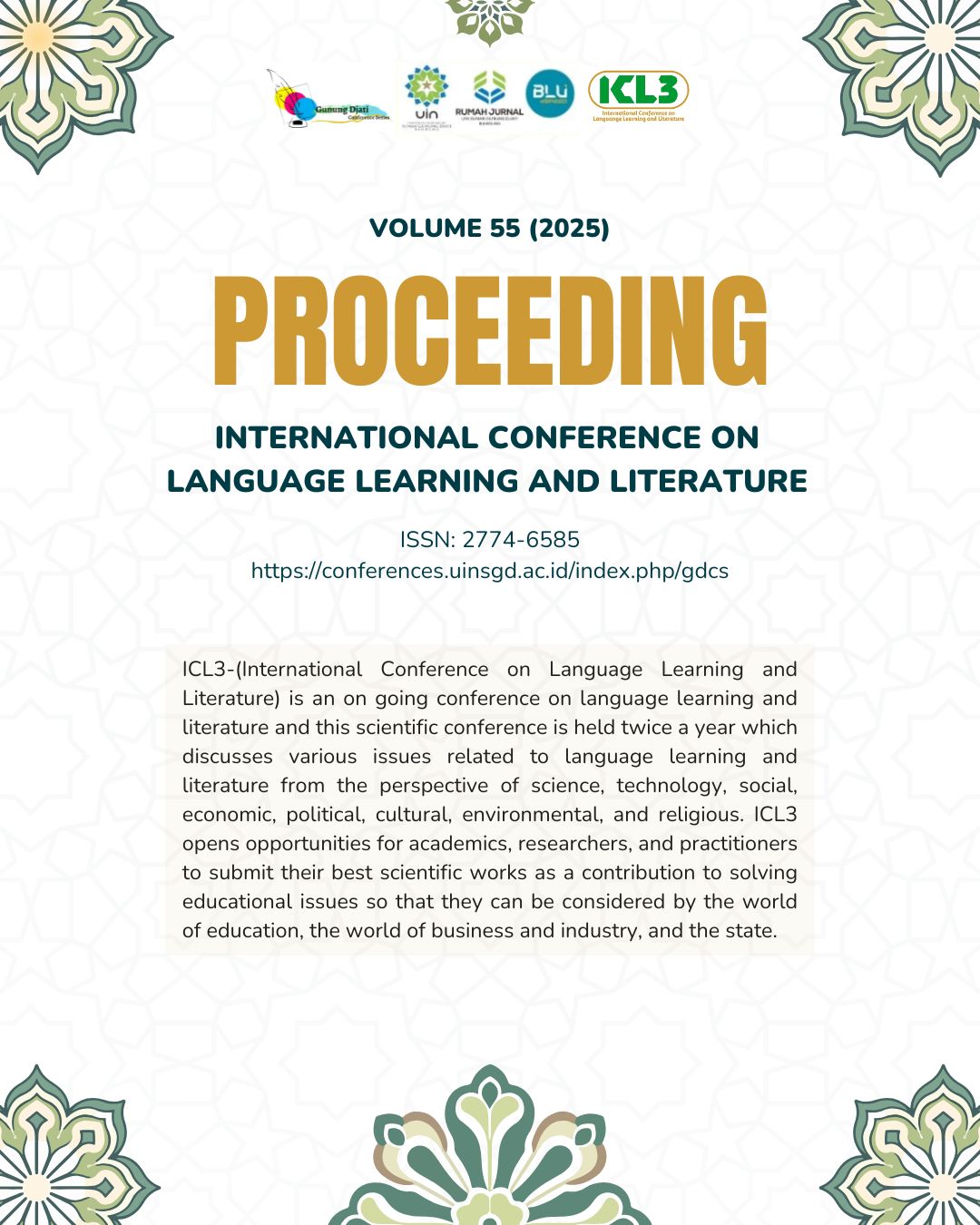Sociological, Psychological, Scientific and Technological Foundations in Designing Arabic Language Curriculum
Keywords:
Arabic Language, Curriculum, Curriculum FoundationsAbstract
To truly understand Arabic and its intricacies, effective and efficient Arabic language learning is necessary. To achieve effective and efficient Arabic learning, careful planning in the form of a curriculum is required. In teaching Arabic language, the curriculum is developed based on certain foundations. The purpose of this paper is to describe the foundations in designing an Arabic language curriculum. This paper focuses solely on the sociological, psychological, scientific, and technological foundations. This study uses qualitative data, which is presented in verbal form rather than in numbers. Data was collected using the literature review technique, namely by studying theories from various relevant sources. After collecting the data, it is presented in the discussion section. The findings of this paper reveal that there are many fundamental aspects to consider before designing an Arabic language curriculum. However, this paper specifically discusses the sociological, psychological, scientific, and technological aspects. The sociological aspect ensures that the curriculum is relevant to social needs. The psychological aspect helps in understanding the mental and emotional development of learners, so that Arabic teaching methods can be adapted to their age, interests, and abilities. Science serves as the foundation for selecting theories that support language skills, while technology facilitates the learning process. These aspects complement each other to create an effective and innovative Arabic language curriculum, so that Arabic learning is not only theoretical but also practical and contextual.
Downloads
References
Abdurahman, R., Rohanda, R., Atha, Y. A. S., Sabarudin, I., & Hilmi, I. (2024). Uslub Istiārah in the Qur'an According to Tafsir Experts and Its Implications for Balāghah Learning. Al Mi'yar: Jurnal Ilmiah Pembelajaran Bahasa Arab dan Kebahasaaraban, 7(2), 630-642. http://dx.doi.org/10.35931/am.v7i2.3713
Ambya, R., Nasir, T. M., Syafe’i, I., & Purnama, W. (2025, April). Scientific Students Critical Thinking Skills on the Fundamental Concept of Morality: Wisdom, Courage, Purity and Justice in the Perspective of Islamic Education. In Muhajirin International Conference (Vol. 1, No. 1).
Amin, B. (2023). Pengembangan Kurikulum Ilmu Pendidikan Bahasa Arab Dalam Konteks Kekinian. AMEENA JOURNAL |Volume, 1(2), 146–154.
Ani Rosidah, Isroani, F., Karim, A. R., Pebriana, P. H., Taryatman, Harisman, Y., Aminah, Harun, L., Bakar, M. T., Amam, A., Takdir, N., Hajiali, I., Tahir, M., Syarif, A., Wahab, A., Ulfa, N. A., Hamzah, Y., Yetti, R., & Masding. (2023). Pengembangan Kurikulum dan Pembelajaran. LovRinz Publishing.
Ardiansyah, A. A., Mukarom, & Nugraha, D. (2024). ANALYSIS OF RELIGIOUS MODERATION UNDERSTANDING AMONG UNIVERSITY STUDENTS IN WEST JAVA. Jurnal Harmoni. https://doi.org/10.32488/harmoni.v23i2.771
Ardiansyah, A. A., Musthafa, I., Syafei, I., & Sanah, S. (2025). Streamlining Arabic Grammar to Facilitate Mastery of Qirâ’at al-Kutub for University Students. Arabiyat : Jurnal Pendidikan Bahasa Arab Dan Kebahasaaraban, 11(2), 221–233. https://doi.org/10.15408/a.v11i2.42517
Camelia, F. (2020). ANALISIS LANDASAN ILMU PENGETAHUAN DAN TEKNOLOGI DALAM PENGEMBANGAN KURIKULUM. SAP (Susunan Artikel Pendidikan), 5(1). https://doi.org/10.30998/sap.v5i1.6474
Desrani, A., & Aflah Zamani, D. (2021). Pengembangan Kurikulum Pembelajaran Bahasa Arab di Masa Pandemi Covid-19. Jurnal Alfazuna : Jurnal Pembelajaran Bahasa Arab Dan Kebahasaaraban, 5(02), 2014–2234. https://doi.org/10.15642/alfazuna.v5i02.1252
Djajasudarma, F. (2010). METODE LINGUISTIK: Ancangan Metode Penelitian dan Kajian (A. Susana (ed.)). PT Refika Aditama.
Fauzan. (2017). KURIKULUM PEMBELAJARAN (F. Arifin (ed.)). GP Press.
Herdah, Saepudin, Mulya, D., Maghfirah, N., & Nuraisyah, T. (2020). Pengembangan Kurikulum Bahasa Arab (H. Herawaty (ed.)). IAIN Parepare Nusantara Press. https://doi.org/10.24090/tarling.v1i2.1248
Hidayati, W., Syaefudin, & Muslimah, U. (2021). MANAJEMEN KURIKULUM DAN PROGRAM PENDIDIKAN (Konsep dan Strategi Pengembangan). Semesta Aksara.
Juanda, A. (2014). Landasan Kurikulum dan Pembelajaran (Z. Arifin (ed.)). CV Confident.
Juanda, A. (2016). Kurikulum dan Pembelajaran Teori dan Praktik KTSP (A. Zaeni (ed.)). CV Confident. http://repository.syekhnurjati.ac.id/4568/1/Buku Kurikulum Pembelajaran KTSP.pdf
Lutfiani, Y., Sanah, S., & Nugraha, D. (2025). The Language Environment Strategy for Developing Language Skills Based on the Communicative Approach. Kalamuna: Jurnal Pendidikan Bahasa Arab Dan Kebahasaaraban, 6(2), 207–222. https://doi.org/10.52593/klm.06.2.01
Muhajir. (2022). PENGEMBANGAN KURIKULUM BAHASA ARAB. Semesta Aksara.
Muradi, A., & Taufiqurrahman. (2021). Pengembangan Kurikulum Pembelajaran Bahasa Arab Konsep dan Aplikasi (Nuraini (ed.)). PT RajaGrafindo Persada. http://scioteca.caf.com/bitstream/handle/123456789/1091/RED2017-Eng-8ene.pdf?sequence=12&isAllowed=y%0Ahttp://dx.doi.org/10.1016/j.regsciurbeco.2008.06.005%0Ahttps://www.researchgate.net/publication/305320484_SISTEM_PEMBETUNGAN_TERPUSAT_STRATEGI_MELESTARI
Niqie, M. S. R., & Ahid, N. (2023). Desain Kurikulum Pembelajaran Bahasa Arab Kontemporer. Indonesian Journal of Humanities and Social Sciences, 4(1), 37–58. https://doi.org/10.33367/ijhass.v4i1.3939
Nur, T., Lukman, F., Nugraha, C., & Malik, M. Z. A. (2022). Pengantar Studi Sosiolinguistik Arab (O. Hodijah (ed.)). Unpad Press.
Rachmawati, M., Fahmi, A. K., & Akbar, D. W. (2021). PENGANTAR PSIKOLINGUISTIK (S. Nahidloh (ed.)). PENERBIT KBM INDONESIA.
Rohanda, R., Mahesa, D. C., & Dayudin, D. (2025). Analisis Afiks pada Fiil Mujarrad dalam Surat Hud. Kalamuna: Jurnal Pendidikan Bahasa Arab dan Kebahasaaraban, 6(1), 63-93. https://doi.org/10.52593/klm.06.1.05
Rokhman, F. (2013). SOSIOLONGUSTIK Suatu Pendekatan Pembelajaran Bahasa dalam Masyarakat Multikultural. Graha Ilmu.
Saleh, A. A. (2018). PENGANTAR PSIKOLOGI. Aksara Timur.
Syafei, I., & Laely, N. H. (2020). IMPLEMENTASI MEDIA BAHASA DALAM PEMBELAJARAN MAHĀRAT AL-KALĀM BERDASARKAN FUNGSI MEDIA PEMBELAJARAN MENURUT KEMP DAN DAYTON. Tsaqofiya :Jurnal Pendidikan Bahasa Dan Sastra Arab, 2(2). https://doi.org/10.21154/tsaqofiya.v2i2.19
Syafei, I. (2025). BUKU KURIKULUM BAHASA ARAB.
Syafei, I. (2025). BUKU KURIKULUM & PEMBELAJARAN. Penerbit Widina.
Syafei, I. (2025). PENGEMBANGAN MODEL PEMBELAJARAN UNTUK MENINGKATKAN KETERAMPILAN MEMBACA.
Tajudin. (2019). Metode Penelitian Linguistik Terpadu (Y. Yohana (ed.)). Unpad Press.
Thohri, M. (2023). Pengembangan Kurikulum (S. Rahmi (ed.)). CV. Al-Haramain Lombok.
Tricahyo, A. (2013). Landasan Filosofis Kebijakan Pengembangan Kurikulum Bahasa Arab. Cendekia: Jurnal Kependidikan Dan Kemasyarakatan, 11(1). https://doi.org/10.21154/cendekia.v11i1.391
Utami, R. L. (2020). Desain Kurikulum Bahasa Arab di Indonesia. EL-IBTIKAR: Jurnal Pendidikan Bahasa Arab, 9(1), 108. https://doi.org/10.24235/ibtikar.v9i1.6235
Yakin, A. (2022). Problematika Pembelajaran Bahasa Arab Di Indonesia Dan Implikasinya Terhadap Pengembangan Kurikulum Bahasa Arab. Dirosat: Journal Of Islam Studies, 7(1), 57–67. https://ejournal.idia.ac.id/index.php/dirosat/article/view/699
Downloads
Published
Issue
Section
Citation Check
License
Copyright (c) 2025 Dinan El Haq Rahimahullah, Isop Syafe'i, Dadan Nugraha

This work is licensed under a Creative Commons Attribution 4.0 International License.



